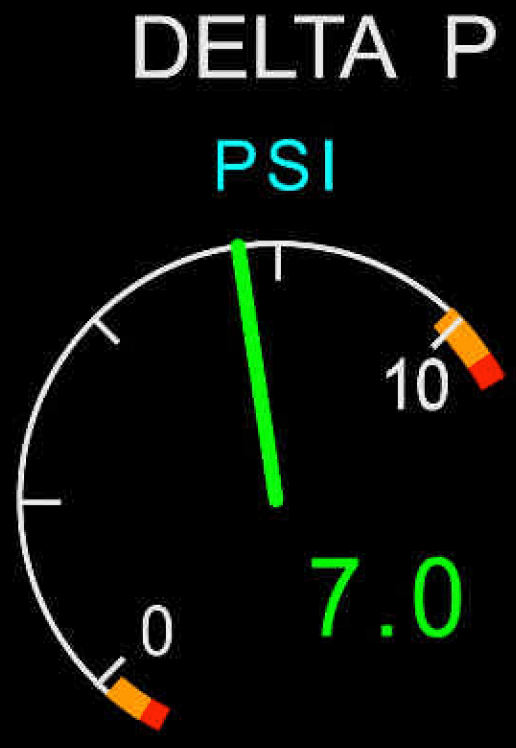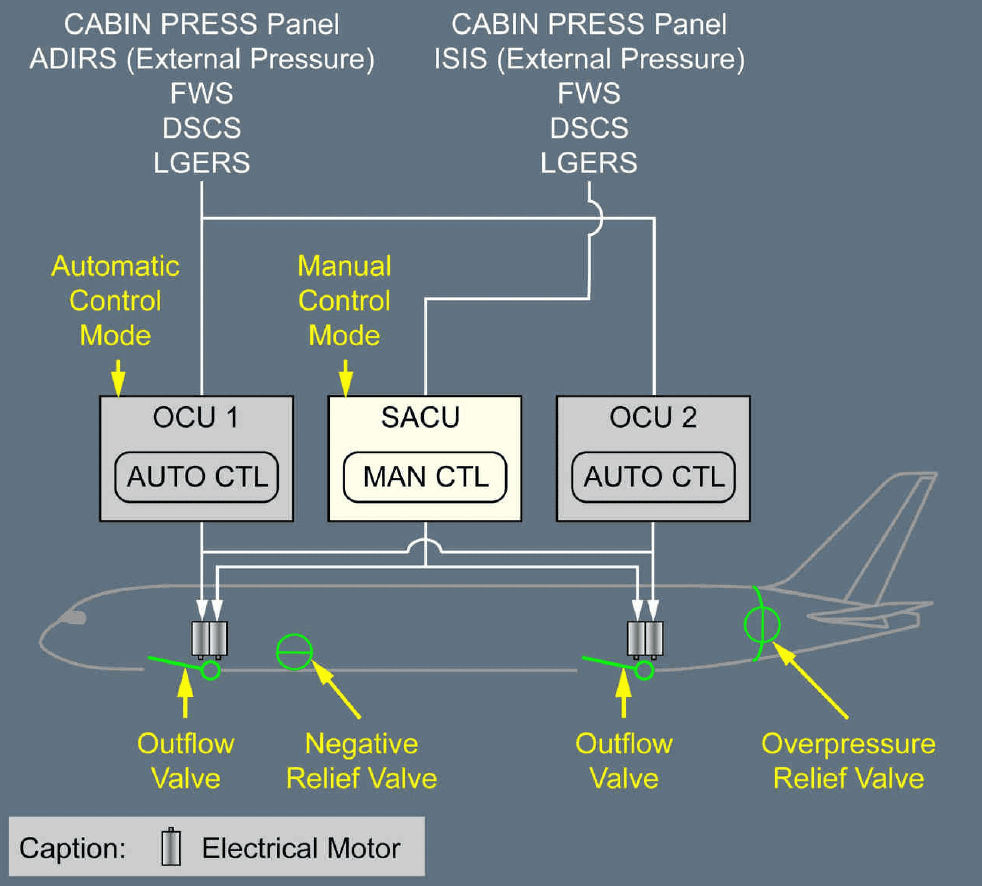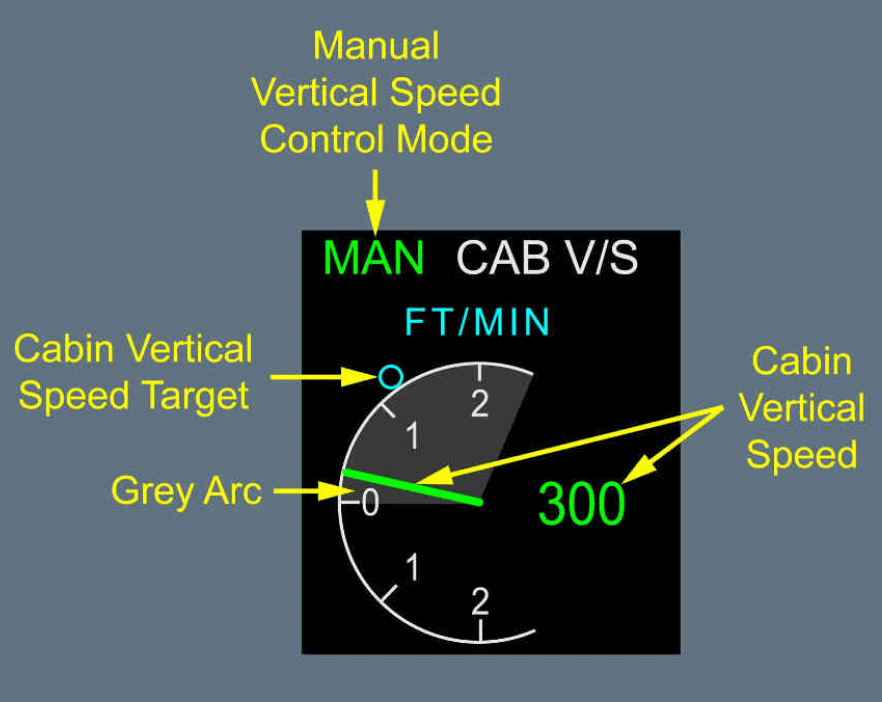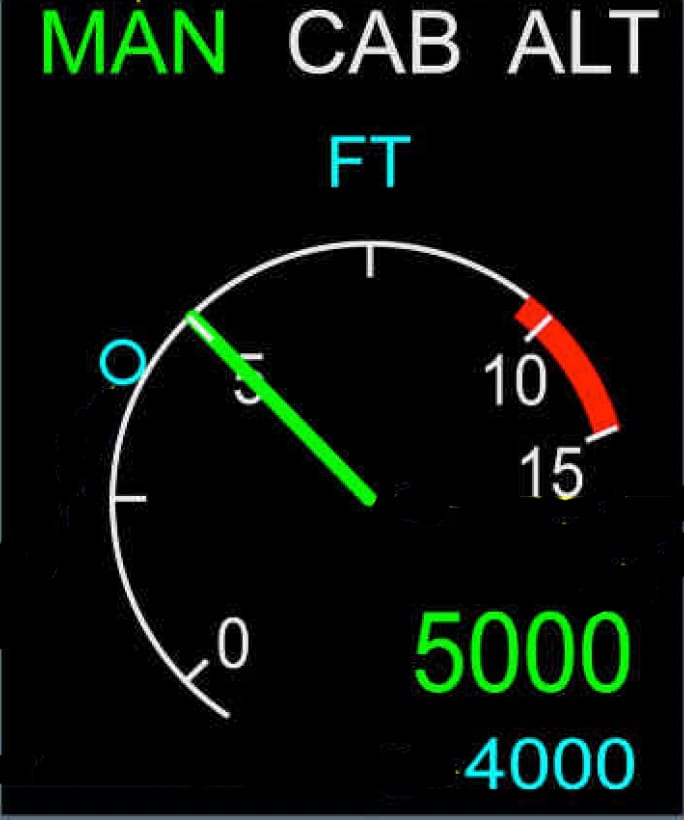The manual pressurization system operates independently of the automatic pressurization system. To obtain the desired cabin altitude and vertical speed, the manual pressurization system uses external pressure from:
During descent, the cabin vertical speed is controlled, to ensure that the cabin altitude reaches ______ the landing elevation prior to landing.
During climb, the cabin vertical speed is determined to reach the scheduled cabin altitude at the top of climb defined by the FMS cruise level. The cabin vertical speed is limited to ______.
The pressurization descent phase occurs:
When the aircraft is above 25 000 ft, the cabin vertical speed is limited to ______. When the aircraft is below 25 000 ft, the cabin vertical speed is limited to ______ .
The aircraft is pressurized at a rate of ______ : this ensures a differential pressure of 0.1 PSI at liftoff.
The pressurization takeoff phase occurs, when:
When the Cabin altitude is manually controlled, the cabin altitude must be manually selected via the _____. The cabin altitude target remains at the current value until the flight crew manually selects a new cabin altitude target.
The cabin vertical speed needle display ranges from:
The pressurization system is in auto mode. If the LDG ELEVN (landing elevation) indicates 7000 ft, this means:

Advertisement
When the CABIN ALT MODE pb-sw is set to MAN, the flight crew uses the selector to manually select the cabin altitude target. Selected cabin altitude target is displayed on the CAB PRESS SD page only.
In the event the pressurization system fails, one independent overpressure relief valve automatically prevents positive and negative cabin pressure from going too high. This valve is located:
The pressurization abort phase occurs, when:
The cabin vertical speed is displayed, when the A/C is in flight. The cabin vertical speed arrow and digital indication pulse in green if:
If the cabin altitude exceeds _____, the ECAM will trigger the red CAB PRESS EXCESS CAB ALT warning on the WD.
What is the true statement?

During cruise the cabin altitude is regulated to remain:
At touchdown, all outflow valves open, to remove the residual differential pressure. Residual differential pressure removal takes:
During automatic operation and before takeoff, all outflow valves close, to ensure there is no differential pressure between the air inside the aircraft and the external air.
Before takeoff all outflow valve open.
Which statement is true?

In automatic mode (when the CABIN ALT MODE pb-sw and CABIN VS MODE pb-sw are set to AUTO), one Outflow valve Control Unit (OCU) automatically controls the cabin altitude target, and the cabin vertical speed. If the differential pressure exceeds the maximum limit of the electronic differential pressure protection, the master OCU is shut off and the remaining OCU takes over control to recover, and opens the two outflow valves.
Advertisement
In automatic mode (when the CABIN ALT MODE pb-sw and CABIN VS MODE pb-sw are set to AUTO), one Outflow valve Control Unit (OCU) automatically controls the cabin altitude target, and the cabin vertical speed. There are two OCUs. OCU1 computes the cabin pressure targets and provides corresponding commands to OCU2. Both OCUs drive their corresponding outflow valve, more open or closed, in order to reach the demanded pressure target. If one OCU fails the other one takes over the control of the two outflow valves.
In MANUAL MODE, The cabin vertical speed target has priority over the cabin altitude target.

A gray arc from 0 fpm to 2 500 fpm appears when the cabin altitude and the cabin vertical speed are both manually controlled, when the cabin vertical speed target is more than the current cabin vertical speed. The gray arc indicates the flight crew the acceptable range to set the cabin vertical speed target. The cabin altitude target has priority over the cabin vertical speed target.
In automatic and manual mode the pressurization system prevents the positive and negative differential pressure from going too high. It also prevents the cabin altitude from going too high. The two outflow valves close when the cabin altitude exceeds _____ in automatic mode and _____ in manual mode.
To regulate the cabin pressure the pressurization system has:
During takeoff, the Cabin Pressure Control System (CPCS) pressurizes the aircraft to provide a smooth variation of the cabin vertical speed at liftoff.
In order to automatically control the cabin pressure, each OCU (Outflow valve Control Unit) uses the FMS flight plan (including the landing elevation), together with current outside air pressure, and air conditioning system status (the landing elevation is necessary to be in automatic mode). The OCUs use an internal pressure sensor to determine the cabin differential pressure, and the cabin altitude. The cabin vertical speed is determined via a predetermined scale.
The aircraft is equipped with one negative relief valve, that operates mechanically with differential pressure. The negative relief valve prevents the negative differential pressure from going too high. The negative relief valve is installed on the right side of the forward part of the aircraft, above the flotation line. The negative relief valve mechanically-opens, in order to not exceed the maximum negative differential pressure, which is equal to:
______ all outflow valves open, to ensure there is no differential pressure between the air inside the aircraft and the external air.
If the differential pressure exceeds the maximum limit of the electronic differential pressure protection, the master OCU (Outflow valve Control Unit) is shut off and the remaining OCU takes over control to recover, and opens the two outflow valves. This limit is equal to:
During cruise, the cabin altitude is regulated not to exceed:
Advertisement
There are two outflow valves:
What is the meaning of this indication?

